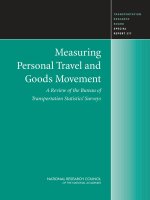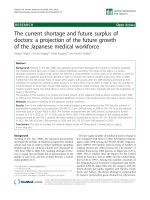New towns development: A wave of the future planning practices in Nepal
Bạn đang xem bản rút gọn của tài liệu. Xem và tải ngay bản đầy đủ của tài liệu tại đây (1.87 MB, 14 trang )
TRIBHUVAN UNIVERSITY JOURNAL, VOL.: 31, NO.: 1 & 2, JUNE/DEC. 2017
139
NEW TOWNS DEVELOPMENT: A WAVE OF THE
FUTURE PLANNING PRACTICES IN NEPAL
Kedar Dahal*
Krishna Prasad Timalsina
ABSTRACT
Increasing urbanization has been a major challenge to tackle
issues relating to population growth, housing, infrastructure development
and urban management in Nepal. Initiatives have been taking by the
stakeholders of urban sectors in different course of action plans. New town
development, smart city development, preparation and implementation
of various strategic plans and action plans are some of the initiatives
undertaken by the Ministry of Urban Development, Government of Nepal.
At present, the Ministry of Urban Development is preparing intervening
plans and programmes to 40 towns for planned urban development in
Nepal. Some of these towns are already in pace of development and some
others are in infancy stages. Balance urban development strategy so far is
a strategy of government of Nepal however theory of political economy of
development is inherently coming in selection of the towns, and basically
in implementing the plans. Therefore, most of the prepared action plans are
in question of effective implementation. Among the prioritized new towns
of Nepal, some of these towns particularly smart cities are in very infancy
stages of infrastructure development in which ‘smartness’ itself falls into
huge dilemma. Therefore, more challenges are added in implementing
the smart cities into action plan. However, new towns of Hilly and TaraiMadhesh area will definitely provide the opportunities to cater population
and create more opportunities. In this context, this study focus on the
new town development and their spatial distribution in Nepal through the
collection of primary information and review of previous literature.
Key words: New towns, tarai-madhesh, smart city, plan intervention,
development, corridor
INTRODUCTION AND OBJECTIVE
The history of urban growth in Nepal begins since 1944. Since
then Nepal has also experienced a rapid urbanization. Many small towns
*
Dr. Dahal is Associate Professor in Geography, Tri-Chandra Multiple Campus,
Ghantaghar, TU, and Mr.Timalsina is currently associated with the Department
of Geography, Tri-Chandra Multiple Campus, Ghantaghar, TU.
140 NEW TOWNS DEVELOPMENT: A WAVE OF THE FUTURE PLANNING ...
and cities were developed in around the Kathmandu Valley and the Tarai
Region of Nepal. In 1952-54 there were 10 urban centres delineated in
Nepal. Among them, five were in the Kathmandu Valley and remaining
five were out of Kathmandu Valley. The number of urban centres rose up
to 16 in 1961 and 23 in 1981. Similarly, the number of urban centres in
1991, 2001 and 2014 were recorded 33, 58 and 191 respectively. At present
federal restructuring context of Nepal, the government has declared 263
municipalities with 6 metropolitan cities and 11 sub-metropolitan cities.
According to population census 2068, total urban population has been
increased by 58.38 percent considering present municipalities of Nepal
(CBS, 2012). Moreover, the number of towns and market centres has been
increasing with the construction of new roads and highway in different
geographic regions of Nepal.
Increasing population pressure in the newly emerging towns have
made more difficult to provide basic physical and social infrastructure and
services. The local bodies have increasingly been facing more difficult to
develop urban areas in a planned way. During 1960s, many people from hill
and mountain were resettled in the Tarai due to displacement from natural
disaster (DUDBC, 2007).During the decade, internal migration increased
inTarai and larger cities of Nepal. Government also focused to larger cities
and towns for planning and infrastructure development which increased
uneven development among the towns and cities of Nepal (Gurung, 1969).
This again became major factors of Hill to Tarai and Rural to urban migration
in Nepal. In 1970s, Regional Development concept was initiated in Nepal.
Four growth poles and several other growth centres were identified in order
to reduce the regional disparity in Nepal. Biratnagar-Dhankuta, HetaundaKathmandu, Bhairahawa-Jomsom, Nepalganj-Jumla were identified as
a main growth poles. The growth pole hypothesis was to establish northsouth linkages in the movement of goods and services, trade and people
with the view to coordination and integrated development activities within
the country (Dahal, 2005). Series of north-south growth axis linking the
diverse region have been defined. Each growth axis was planned to connect
road. These roads will link a series of growth centres where development
efforts will be concentrated in order to achieve full economics of scale and
encourage agglomeration economies (Gurung, 1969). The important aspects
of the growth centres is the positive nature of polarized development as it
takes place and the mechanisms whereby the growth centres spreads growth
to the surrounding areas. Master plan of four regional headquarter (e.g.
Dhankuta, Pokhara, Surkhet and Dipayal) was prepared and implemented
TRIBHUVAN UNIVERSITY JOURNAL, VOL.: 31, NO.: 1 & 2, JUNE/DEC. 2017
141
in this period (DUDBC, 2007). But proper implementation of these master
plans was not success due to lack of institutional and legal mechanisms.
In 2007, the Government of Nepal enacted and has been
implementing National Urban Policy for balance urban development in
Nepal (DUDBC, 2007). The policy was implemented to develop balance
urban growth in the country by prioritizing investment to the lagging
regions for development of regional cities and intermediate towns.In this
context with an objective of reducing migration to Kathmandu and other
larger cities, encouraging planned development of potential hill cities and
building infrastructure that can facilitate and attractthe population in the
hilly cities, the Government of Nepal has started to develop 10 new towns
in Mid-Hill Highway corridor of Nepal since 2068 B.S. It was one of the
turning points of the government to develop planned cities in Hilly areas of
Nepal. Moreover, two new towns in Hilly Region namely; Bheriganga in
Surkhet District and Bhingri in Pyuthan District are also in execution phase
of the government of Nepal. Recently, government of Nepal has executing
plan intervention in the Tarai Towns of Nepal, particularly in the growing
potential towns of Tarai-Madhesh Region. 15 new towns from the Tarai
region have been selected for plan interventions (DUDBC, 2074 B.S.a.).
Main objective of developing new towns in Tarai-Madhesh Region is to
contribute balance urban development and develop liveable cities in TaraiMadhes area of Nepal so that stagnant areas would be served and connected
by the newly developed towns of the Tarai-Madhes region.
Likewise, 13 smart cities are also in process of plan intervention
by the government of Nepal. Lumbini, Nijgadh and Palungtar are already
entered into the phase of plan preparation of smart cities and other ten smart
cities namely: Dhankuta, Mirchaiya, Kavre Valley, Chandrapur, Bharatpur,
Waling, Tulsipur, Dullu, Tikapur and Amargadhi are in process of plan
preparation (DUDBC, 2074 B.S.). All together 40 growing cities of Nepal
are in priority focus of the government for plan intervention and execution
for urban development to foster balance urban development as postulated
in the National Urban Policy of Nepal. Therefore, this study focuses on
the spatial distribution of new towns in Nepal with reference to urban
development and planning practice in Nepal.
METHODS AND DISCUSSION
This article is based on both primary and secondary data which was
collected during the process of new town selection, plan preparation of both
Mid-hill Highway towns and Tarai-Madhesh towns of Nepal in different
142 NEW TOWNS DEVELOPMENT: A WAVE OF THE FUTURE PLANNING ...
periods of 2011, 2015 and 2016. Town selection criteria were prepared
by reviewing the existing literature and documents in close coordination
with implementing agency such as Department of Urban Development and
Building Construction (DUDBC) and New Town Project Coordination
Office (NTPCO).In case of new town selection in Mid-hill highway corridor
region, primary criteria such as land availability, situation of drinking water,
economic development potentiality (industrial development and availability
of natural/human resources) were used. And, secondary criteria such as
location, transportation and communication, administrative hierarchy of the
town, rural-urban linkages, non-agricultural activities, existing large scale
investment in the vicinity of the townavailable social/community services
were used for town selection (DUDBC, 2068 B.S.).
In selection new towns of Tarai-Madhesh Region, criteria
such as land availability, population, density, nodal junction, economic
development potentiality (market centre, industries), population engaged
in non-agricultural activities, sources of drinking water, in-migration rate,
availability of government services, literacy rate, access of road etc. were
used (DUDBC, 2074 B.S.). Potential new towns from the Tarai-Madhesh
area were selected through the series of screening process from the list of
potential towns. In studying the specific potentials of a particular town,
fieldwork was conducted. Participatory fieldwork is the central and
important method for collecting the primary information as the method
can well explain the contextual situation (Timalsina, 2011). Observation
(participatory and non-participatory), key informants interview, informal
conversational interview, participatory consultations were used to collect
primary information whereas secondary information were collected from
published and unpublished literature/documents. In planning process,
participatory interactional consultations were done to select towns in MidHill Highway Corridor and Tarai-Madhesh Area.
New towns in the mid-hill highway corridor
The Mid-hill Highway-also called Pushpalal Highway which
starts from Chiyo Bhanjyang of Panchathar District in the East and ends
at Jhulaghat of Baitadi District in the Far-west connecting hilly districts of
Nepal. With a length of 1776 km, this highway connects 24 hilly districts
directly affecting about 7 million people (DUDBC, 2068 B.S.). It is
envisaged to provide easy access to many of the less accessible and often
stagnant communities in the Mid-hill area of Nepal. Marked by low income
and increasing out-migration of unemployed youthas well as poor access
to public services, these hilly communities are expected to benefit from the
TRIBHUVAN UNIVERSITY JOURNAL, VOL.: 31, NO.: 1 & 2, JUNE/DEC. 2017
143
easier access to markets in Tarai and other higher level market centres of
the Region. The government brought this ambitious project of developing
cities to reduce growing human pressure in the big cities including the
Capital City, Kathmandu (DUDBC, 2068 B.S.). It is believed that with the
completion of the project, migrations to the new cities would grow and
population would be hold in these towns by providing services and creating
marketing opportunities there. Newly developed towns would create ample
of opportunities within the new town and thereby it reduces out migration.
It was one of the main strategies of balance urban development in the Hilly
Region as per objectives stated in the National Urban Policy.
The new towns of Mid-Hill Highway corridor are: Phidim
(Panchthar), Basantapur (Terhathum), Khurkot (Sindhuli), Baireni-Galchh
(Dhading), Dumre-Bhansar (Tanahun), Burtibang (Baglung), Chaurjahari
(Rukum), Rakam-Karnali (Dailekh), Safebagar (Achham) and Patan
(Baitadi). These towns belong 2 in each Development Region which
seems adoption of balance urban development strategy in the hilly region
(DUDBC, 2068 B.S.).Distribution of 10 new towns along the Mid-Hill
Highway Corridor of Nepal is shown in Map 1.
Map 1: Distribution of 10 New Towns along the Mid-Hill Highway of Nepal
144 NEW TOWNS DEVELOPMENT: A WAVE OF THE FUTURE PLANNING ...
At present, the government has been investing in its infrastructure
projects specially road improvement, land development, drainage
construction, construction of sanitary land fill site, water supply and
construction of other urban infrastructure projects in the new towns.
However, as being hilly towns and increasing tendency of pre-occupancy of
land by the elites, land availability for construction of public infrastructures
has been one of the growing challenges in most of the these towns
(NTPCO, 2073 B.S.). Therefore, new town project office is increasingly
facing challenges to acquire land for construction of urban infrastructures
in these towns. In addition to this, due to the lack of political commitments,
cooperation and low capacity of implementing agencies, implementation of
plans have been quite challengeable. Allocated budget expenditure pattern
in most of the towns seems very low.
New towns in the tarai-madhesh region
The government of Nepal has also started to develop new towns
in the Tarai-Madhesh Region of Nepal. The government has already
selected 15 new towns in the Tarai-Madhesh region with an objective of
expandingsettlements in the Tarai-Madheshto promote planned urbanization.
The new towns are located either in the East-west Hulaki Highway or feeder
roads connecting East west highway to district headquarters and other
towns of Tarai Region. These new towns are: Gauriganj (Jhapa), Rangeli
(Morang), Sambhunath (Saptari), Balawa (Mahottari), Manara (Mahottari),
Ishworpur (Sarlahi), Brahmapuri (Sarlahi), Katahariya (Rauahat), Maulapur
(Rautahat), Mahagadhimai (Bara), Bardaghat (Nawalparasi), Gadhawa
(Dang), Rajapur (Bardiya), Bhajani (Kailali) and Belauri (Kanchanpur)
(DUDBC, 2074 B.S.a). Distribution of 15 new towns of Tarai- Madhesh
Region is shown in map 2.
TRIBHUVAN UNIVERSITY JOURNAL, VOL.: 31, NO.: 1 & 2, JUNE/DEC. 2017
145
Map 2: Distribution of 15 New Towns in the Tarai-Madhesh Region of Nepal
There are two different views regarding the Hulaki Highway
alignment. One view is that only the Highway passing through East to
West parallel to East-West Highway (Mahendra Highway) is called Hulaki
Highway whereas another view is that the East-west Hulaki Road as well as
feeder roads connecting to various district headquarters and towns of Tarai
Region of Nepal are also called Hulaki Road. Chairman of the Development
Committee, House of Representative, Mr. Rabindra P. Adhikari arguing the
second view explains:
‘Most people think that Hulaki highway is only the highway
extending east to west parallel to (East-West) Mahendra Highway of Nepal,
but we all should keep in mind that 32 sections of north-south feeder roads
of 917 km length connected various district headquarters and towns of
Tarai, and 975 km length east-west Hulaki roads with total length of 1792
km roads collectively called Hulaki Highway (Adhakari, 2017).
Arguing to firstview, Honourable Ministry for Urban Development
Mr.Prabhu Shah in a conversation explains that ‘there is no Hulaki Highway
passing north-south in Nepal. The north-south roads are feeder roads, just
put them in a basket of Hulaki Project for construction purposes. As I have
been struggling throughout my life long political career to this Hulaki Road
146 NEW TOWNS DEVELOPMENT: A WAVE OF THE FUTURE PLANNING ...
of Tarai, How I can agree the feeder roads are Hulaki Highway.Therefore,
Hulaki Highway is only those roads passing East-west in the Tarai Region
of Nepal. Therefore, Hulaki Highway is only those roads passing East-West
in the Tarai region of Nepal.
A local resident and politician of Ishworpur supporting to second
view says:
I am the resident of this town, and have been working for the
public when I started my political career. The road connecting to Phuljor
(Mahendra Highway)-Bayalbas- Tribhuwannagar is a Hulaki road which
every people know here in Ishworpur.
There is no doubt that some north-south feeder roads are Hulaki
roads. Studying to those statements as well as fieldwork impressions
through consultation at local level, it indicates that Hulaki Roads are in
two different categories; one-East-West Hulaki road runs some 20 to 30
kilometres south, parallel to the East-West (Mahendra) highway and two—
an approach or feeder road connecting (North-South and sometimes parallel
to East-West Hulaki road) to the districts head-quarters and other towns
of the Tarai-Madhes areas of Nepal. However, both categories of Hulaki
roads are considered the lifeline of the Tarai region, as it links 20 districts,
maintowns and settlements of the Tarai with a good road networks. The
government believes that new cities to be developed in the Tarai-Madhesh
would lead to the expansion of settlements in a systematic way in the
Tarai-Madhesh region thereby discouraging the construction of unplanned
towns. It is also expected to develop selected towns as new cities with good
provision of physical and public infrastructures which will be the pulling
centres of population through the surrounding areas thereby discouraging
the out migration.
While selecting potential towns of Tarai-Madhesh, primary
criteria such as road connectivity, minimum population threshold, basic
level of existing infrastructures were considered. After then, detail criteria
such as availability of land, population, density, potentiality of economic
development, population involved in non-agriculture sector, availability
of water resources, migration, situation of government facilities, literacy
and access to road facilities were used (DUDBC, 2074 B.S. b). Based
TRIBHUVAN UNIVERSITY JOURNAL, VOL.: 31, NO.: 1 & 2, JUNE/DEC. 2017
147
on the defined criteria new towns were selected for further planning and
development intervention.The ‘Political Economy of Development’ (Fox,
2013) in town selection is perceived and reflected in most of the town
development in Nepal. Inherently within the theory of ‘Political Economy
of Development’, 10 towns have been selected from different districts as
‘Hulaki Highway Towns’ whereas 5 towns have been selected as ‘TaraiMadhesh Towns’. However, government of Nepal is planning to develop
all these 15 towns as New Towns of Tarai-Madhesh Regionas ‘Emerging
Towns’ which is in itself a good initiation. It should also be noted that
Central Tarai area is one of the focussed area of urban development of the
government of Nepal and therefore, more number of new towns are selected
from central Tarai region. It is expected that these new towns willget an
opportunity of development as important cities in this region and thereby
will be established as a strategic towns.
Further, the government of Nepal is planning to prepare an
integrated urban development plan of the selected new towns for systematic
plan development for intervention. The integrated urban development plan
will cover sectoral plan such as physical development, social development,
environmental management, economic development, institutional
development, multi-sector alinvestment, disaster risk management (DUDBC,
2072 B.S.) etc. Yearly budget allocation would be made available on the
basis of prepared integrated development plan of the towns. Therefore, the
integrated urban development plan for the new towns will be importantway
forward for execution of projects at town level for intervention.
Other cities in pipeline
Other cities are also in course of action for implementing urban
development projects in Nepal. Two new towns-one each from Pyuthan
and Surkhet district, are also selected for planning interventions. Bhingri,
a new town, considering present Swargadwari Municipality, located at the
edge of Madi River is one of the potential towns of Pyuthan district. It
has potentiality of tourism and agriculture development for the basis of
urbanization. Similarly, Bheriganga Valley is another new town located in
Surkhet District covering present three municipalities namely Bheriganga,
Gurvakot and Lekhbeshi. These municipalities are located at the Bheri
River Valley covering lower level of Bheri River basin and upper hilly area
148 NEW TOWNS DEVELOPMENT: A WAVE OF THE FUTURE PLANNING ...
(DUDBC, 2074 B.S.). The government is also planning to develop these
new towns in a planned way and therefore, planning to establish a project
office to execute plans and programmes (NTPCO, 2072). Smart cities
are other towns that Nepal Government has recently been focussing for
development. Three smart cities namely; Lumbini, Nijgadh and Palungtar
are recently entered into conceptual planning phase. Other 10 smart cities
namely; Dhankuta, Mirchaiya, Kavre Valley, Chandrapur, Bharatpur,
Tulsipur, Tikapur, Dullu and Amargadi are in process of planning (NTPCO,
2074 B.S.). Among these smart cities, some are matured cities such as
Bharatpur, Tikapur, Dhankura and Lumbini where as other cities such as
Dullu, Palungtar, Waling are in infancy stages of development. Among
these smart cities, 7 are situated in Tarai Region and 6 are situated in Hilly
Region including Tulsipur.
In Nepal, concept of smart city has been coming into discussion among
the planners and development practioners recently. A smart city is an
urban development vision to integrate information and communication
technology (ICT) in a secure fashion to manage a city's assets (MUD, 2015).
These assets include local departments' information systems, schools,
libraries, transportation systems, hospitals, power plants, water supply
networks, waste management, law enforcement, and other community
services (DUDBC, 2074 B.S. c). A smart city is promoted to use urban
informatics and technology to improve the efficiency of services (MUD,
2015). ICT allows city officials to interact directly with the community
and the city infrastructure and to monitor what is happening in the city,
how the city is evolving, and how to enable a better quality of life. Basic
characteristics of smart mobility are; smart home, smart society, smart energy,
smart building, smart working, smart governance etc. (DUDBC, 2074 B.S.
c). While looking into the concept of Smart City, two basic themes are
very important to be linked with. They are database and database operating
system (Technology). Database on the one hand is necessary to identify
the existing urban status (population, infrastructures, services etc) and for
linking it to the information technology, and technology itself is necessary
to make urban service easier, safer, and guaranteedfor urban residence.
These two are interlinked to each other which are the hurt of smart city. The
concept of a Smart City goes beyond the transactional relationships between
citizen and service provider. It is essentially enabling and encouraging the
TRIBHUVAN UNIVERSITY JOURNAL, VOL.: 31, NO.: 1 & 2, JUNE/DEC. 2017
149
citizen to become a more active and participative member of the community,
for example, providing feedback on the quality of services or the state of
roads and the built environment, adopting a more sustainable and healthy
lifestyle, volunteering for social activities or supporting minority groups
(MOUD, 2015). Map 3 shows the distribution of new towns and smart
cities in Nepal. If we look at the distribution of towns on the map of Nepal,
Tarai Region of Central Nepal (province 2) has clustered more cities/towns.
Among 40 towns, 11 towns are located in the province no 2. This reveals
that government of Nepal has given priority of urban development in this
province. Moreover, ‘political economy of development’ again, to some
extent, has reflected on this issue from the beginning of town selection and,
of course, will effect on implementation of the project which is always
there that development planners are frequently facing.
Map 3: Distribution of 40 Strategic Towns in Nepal
CONCLUSION
Nepal Government is putting its effort in planned urban development
since 1944 and has been implementing various plans and programmes in
the urban sectors. At present, the government is giving attention of urban
150 NEW TOWNS DEVELOPMENT: A WAVE OF THE FUTURE PLANNING ...
development through new town development, smart city development,
preparation and implementation of various types of other action plans under
the Ministry of Urban Development, Department of Urban Development and
Building Construction (DUDBC). The Department is preparing intervening
plans and programmes to 40 towns for planned urban development. Among
these towns, 15 new towns are located in Tarai-Madhesh Region, 10
new towns are located in Mid-Hill Highway corridor of Hilly region, 2
more new towns are also located in Hilly region- one each in Pyuthan
and Surkeht district. Similarly, 13 smart cities are located both in Tarai
and Hilly districts. While talking about the federal distribution of these 40
new towns, 11 new towns are from province no 2. This means government
is focussing to develop cities in lagging areas so that stagnant areas and
population would be connected in the planned city network. Some of these
towns are already in some pace of development and some others are in
infancy stages.
Looking at the present planning practice in Nepal, future
interventions tend to be more political and new planning approaches will
be coming into front among the implementing agencies. Smart city will
be more fashionable and political actors are pushing the terminology for
catching up the public sentiments. However, smart city planning needs to
be contextualized. First of all improvement and expansion of infrastructure
development focusing on actual need of locals in most of the city plans will
definitely come in the priority interventions. Present planning intervention
has been observed that ‘Political Economy of Urban Development’ is
played a role to some extent in implementing development plans into action.
Hence, future wave of planning needs to be technological driven and actual
need baseof locals rather than imposing some political interests. In other
words, future planning wave should be‘apolitical’ rather than a ‘political’
one which should address local community’s actual needs.
WORKS CITED
Adhikari, R., (2017). Hulaki Rajmargara Madhes ko Bikas (in Nepali).
Kantipur Daily Newspaper, p.5.
TRIBHUVAN UNIVERSITY JOURNAL, VOL.: 31, NO.: 1 & 2, JUNE/DEC. 2017
151
CBS., (2012). National population and housing census (village development
committee and municipality). Kathmandu: Central Bureau of
Statistics, Government of Nepal.
Dahal, K., (2005). Research note: revitalization of the regional development
agenda in Nepal: Lessons from British model. Contributions to
Nepalese Studies. Vol.32. (2), Kathmandu: CNAS, TU.
DUDBC., (2007). National urban policy. Kathmandu: Ministry of Physical
Planning and Works, Government of Nepal.
- - - (2013). Planning norms and standards. Kathmandu: Department of
Urban Development and Building Construction, Ministry of Urban
Development, Government of Nepal.
- - - (2014). Business plan. Kathmandu: Department of Urban Development
and Building Construction, Ministry of Urban Development.
- - - (2068 B.S.). Feasibility study of potential towns in mid hill highway
corridor. Kathmandu: Governemnt of Nepal.
- - - (2072 B.S.). Preparation of integrated development plan of phidim
and basantapur new towns. Kathmandu: Governemnt of Nepal.
- - - (2074 B.S.(a)). Feasibility study of new towns in the tarai-madhesh
area of Nepal. Kathmandu.
- - - (2074 B.S.(b)). Preparation of strategic urban development plan of
new towns in Pyuthan and Surkhet district. Kathmandu: DUDBC.
- - - (2074 B.S. (c)). Preparation of concept and indicators for smart
cities in Nepal. Kathmandu.
Fox, R. S., (2013). The Political Economy of Urbanization and Development
in Sub-Saharan Africa. London: An Unpublished PhD Thesis,
submitted to London School of Economics and Political Science.
Gurung, H., (1969). Regional development planning for Nepal. Kathmandu:
National Planning Commission, Government of Nepal.
MOUD., (2015). National urban development strategy. Kathmandu:
Ministry of Urban Development, Government of Nepal.
MUD., (2015). Smart cities, mission statement and guidelines. India:
Ministry of Urban Development.
152 NEW TOWNS DEVELOPMENT: A WAVE OF THE FUTURE PLANNING ...
NTPCO., (2073 B.S.). Economic development plan of Phidim and Basantapur
new town. Kathmandu: New Town Project Coordination Office.
Timalsina, K.P., 2011. Struggling for livelihood: Making a living in the
urban informal sector. Germany: VDM Verlag &. Müller.









